Nội dung bài viết
Electric arc is considered a “hidden enemy” of every electrical system when just a few smoldering sparks can develop into a fire if not detected and handled promptly. In this case, installing AFDD will help prevent any risks related to arc faults. So what is AFDD? What is the structure and operating principle of this device? Please follow our following article to find out.
What is an electric arc?
An arc fault is a dangerous electrical discharge that occurs at open contact points between two or more different conductive elements. This incident can produce large amounts of heat up to 6,000°C at the arc outbreak location, enough to melt the insulating shell and destroy the circuit. If not detected promptly, it can cause serious problems such as short circuits and fires.

There are many causes of arc faults, mostly due to electric current breaking down the insulation layer between two conductive elements in cases such as:
- Cable broken underground, broken
- Cables are worn and aging
- Cables are damaged by drilling, chiseling, or mouse bites
- Stripping the wire sheath causes the cable core to break
- Loose connection
- Lost connection at the plug end…

Worth mentioning, electric arcs often occur at very small currents (about 2-10A), and do not create short circuits, electric leakage or obvious power outages, so common protective devices such as MCB, MCCB, RCBO… are very difficult to detect. Therefore, sparks generated from the arc can smolder for many hours before erupting into an electrical fire.
What is AFDD? Structure of AFDD
AFDD (Arc Fault Detection Device) is a specialized device responsible for detecting all forms of arc and automatically interrupting the circuit to protect the system against the risk of fire and explosion. Applying high-frequency electric wave analysis technology, AFDD is capable of accurately detecting arc faults even when they have not exceeded the specified threshold, providing comprehensive protection compared to conventional switching devices.
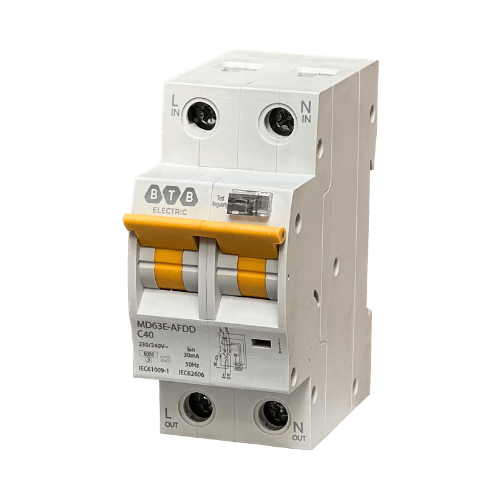
AFDD has a compact design, so to suit the ability to effectively detect and handle electric arcs, the device is integrated with many smart electronic and mechanical components. Below are typical parts that make up AFDD.
- Current Sensor circuit (Current Sensor): Important input signal identification part of AFDD, responsible for continuously monitoring the current passing through the circuit to promptly detect abnormal fluctuations in amplitude and frequency of the current that may be related to the arc.
- Microprocessor (Microcontroller/MCU): Considered the “brain” of AFDD with the ability to analyze real-time electric current signals collected from sensors. The MCU uses advanced algorithms to determine the arc’s characteristic wave pattern and eliminate common interference signals (from turning switches on and off, starting up high-power equipment).
- Digital Signal Processing (DSP): Specialized signal processing module, capable of filtering out common noise signals and leaving only the characteristic waveforms of the arc. DSP plays an important role in accurately determining electric arcs, avoiding unnecessary circuit breaks.
- Tripping Mechanism: When a dangerous arc incident is identified, this part will immediately interrupt the circuit within a few milliseconds, ensuring that the electric spark does not have enough conditions to develop into a fire.
- Protective cover: Often use fireproof materials, high heat resistance, mechanical impact and harsh weather conditions.
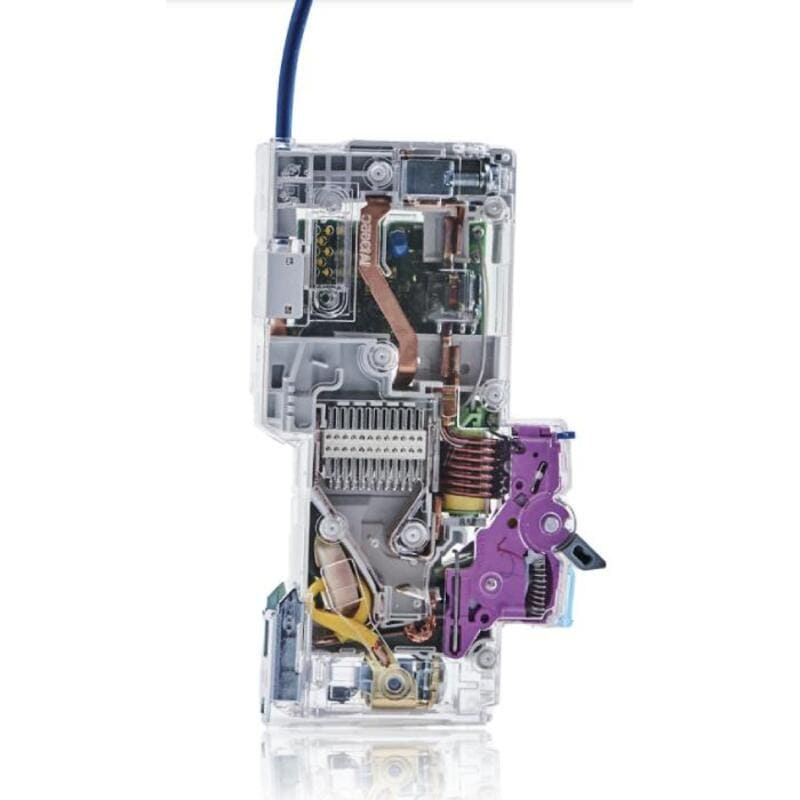
In addition, some smart AFDD lines are also equipped with an LCD screen to display important information such as device status, system error logs and user warnings, or storage memory that allows engineers to remember the history of when arcs occurred, number of circuit breaks… from there to plan to renovate and upgrade the electrical system.
Integrating advanced technology as above helps AFDD optimize size, save electrical cabinet space and is suitable for installation in many different spaces.
Operating principle of AFDD
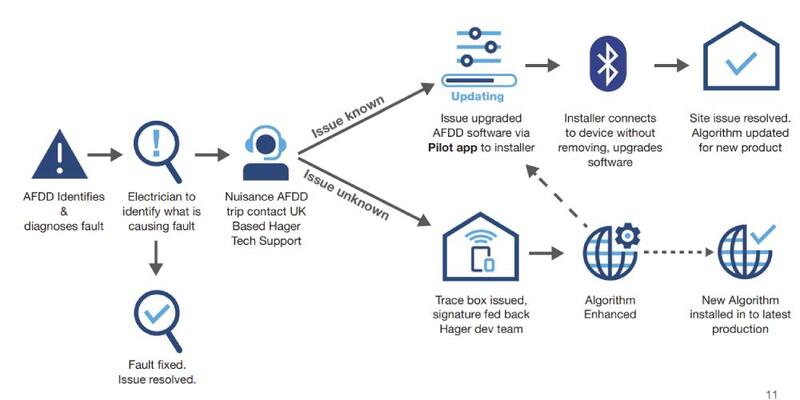
AFDD relies on electronic technology and microprocessors to monitor and analyze current signals (waveforms) in real time, thereby selectively distinguishing between harmless arcs and dangerous arcs. This process includes the following steps:
- Current monitoring: As soon as power is supplied, the current sensor in the AFDD will begin to continuously and comprehensively monitor the current in many aspects such as intensity, oscillation frequency, electrical pulse amplitude, waveform, electromagnetic interference…
- Arc fault analysis: When there are signs of abnormalities in the electrical current, including abnormal wave patterns (unstable sawtooth waveforms), high frequencies and intermittent high-frequency noise, the AFDD’s central processor will compare the noise pulses from normal equipment to determine whether it is an arc fault or normal oscillation.
- Instant circuit breaker: If a dangerous arc is identified, AFDD’s circuit breaker will operate in just a few milliseconds, helping to prevent the arc right from its onset.
- Remember and warn: Some smart AFDD lines, after breaking the circuit, will record information into storage memory to serve the process of tracking, maintenance, and upgrading by engineers.
Role of Electric Arc Detection Device
According to a report by the Fire and Rescue Police Department, up to 70% of fires and explosions nationwide each year originate from failures in electrical systems and equipment. In particular, not short circuit or overload but arc fault is the main cause of electrical fires. Therefore, AFDD installation is a comprehensive solution to:
- Fire Prevention: AFDD has the ability to detect and handle arc faults right from the onset stage, limiting the risk of fire spread.
- Comprehensive protection: The device provides many layers of protection for the electrical system such as arc protection, overload, short circuit and electric leakage, and also detects errors that are difficult to detect with conventional protection devices such as broken underground wires, loose connections…
- Increase system lifespan: Early detection of arc faults helps reduce significant damage to people and property, saving maintenance and replacement costs.
- Comply with safety standards: AFDD needs to meet international standards such as IEC 62606 and IEC 60947, ensuring absolute safety for the system and people, avoiding legal risks.
Application of AFDD
The United States National Electrical Code (NEC) and Canadian Electrical Code (CE) require that AFDD be installed in all circuits supplying power to bedroom receptacles in apartments. The wiring code (AS/NZS 3000:2018) also recommends that all final sub-circuits rated up to 20A be located in bedrooms of schools and nursing homes; Crowded places such as cinemas, subway stations, shopping centers, specific locations such as museums, relics or some areas at risk of fire and explosion, containing flammable materials that need to be protected with AFDD – applicable in New Zealand.
In addition to AS, BS EN 62606 standard stipulates that AFDD should be placed at the end circuits of single-phase AC power for sockets with a rated current not exceeding 32A in residential buildings, student housing, nursing homes, etc.
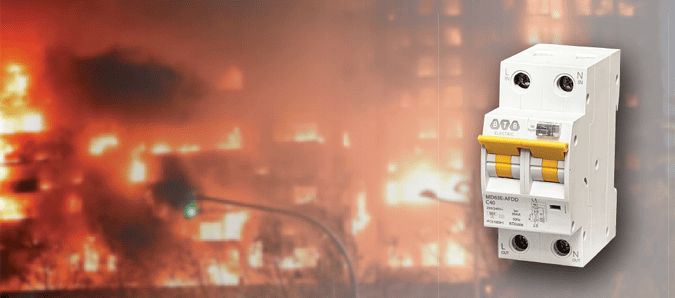 KTH ELECTRIC” >
KTH ELECTRIC” >
In Vietnam, although AFDD is not a mandatory device for systems, according to the US National Electrical Code, arc protection devices should be installed at important locations in the house as follows:
- Kitchen
- Bedroom
- Dining room
- Living room
- Library
- Lobby
- The laundry area…
Besides, AFDD is also widely used in many projects from civil to commercial and industrial.
- High-rise apartments and luxury apartments: Installing AFDD in areas where many high-capacity devices are used such as kitchens, laundry areas or areas with sockets and old equipment helps prevent fire and explosion incidents that can affect neighboring households.
- Factories and industrial workshops: AFDD is often installed in areas with conductors subject to vibration, impact or warehouses containing flammable materials to promptly detect arc incidents that are difficult to control with the naked eye.
- Hotels, shopping centers: The suitable location for installing AFDD is the electrical distribution panels of air conditioning and lighting systems to minimize the risk of smoldering sparks developing into fires.
- Hospitals, schools, libraries: Necessary environments must be equipped with AFDD to ensure absolute safety due to the characteristics of crowded people and the possession of many sensitive electronic equipment or easily causing fire spread.
- Special projects: Such as historical relics, museums, and R&D centers, which contain materials that cannot or are very difficult to recover after a fire, so they require comprehensive protection against fire and explosion incidents.
- Solar power system: This system can easily generate arcs in electrical cabinets, DC wires, and inverters if poor quality wires are used or connected incorrectly. AFDD will detect all types of arcs, ensuring the solar power system operates stably.
Distinguish AFDD from MCB, MCCB, RCBO and RCCB
The most obvious difference between AFDD and conventional switchgear lies in the ability to detect and distinguish dangerous arc faults. Because arc faults often occur at very small current intensity and do not exceed the protection threshold of the CB, switching devices such as MCB, MCCB, RCBO and RCCB are very difficult to identify. Meanwhile, AFDD is designed to detect all types of arcs such as parallel, series or ground fault, providing more comprehensive protection for the electrical system.
The differences between AFDD and conventional switching devices are in the following table:

Comprehensive protection solution from KTH ELECTRIC‘s AFDD
KTH ELECTRIC‘s AFDD is designed to identify abnormal arc forms (including parallel and series) in all systems, even when the current is still within the normal range, and has the ability to interrupt the circuit after only a few milliseconds when an arc is detected, enough to extinguish the problem when it is just in the initial stage.
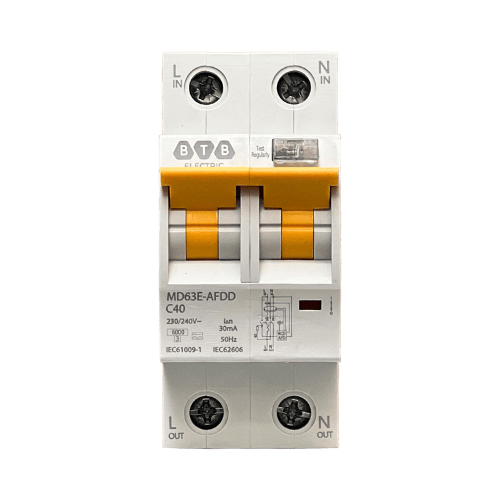
With a rated current range of 6~40A, short circuit breaking current of 6~10kA, leakage current interrupting level of 10~100mA, and 2 product codes: MD63E and MD63S, our arc detector is the optimal choice to prevent explosions and fires in many systems from civil to industrial and commercial, especially applications that require high fire safety.
In particular, KTH ELECTRIC‘s AFDD is a product that integrates the functions of MCB, MCCB, RCBO and RCCB in a single device including: arc protection, overload protection, short circuit protection, leakage current protection and overvoltage protection, providing comprehensive protection against all incidents in all operating conditions. The device strictly meets international standards IEC/BS 62606 and IEC/EN 61009-1, contributing to ensuring legality and improving system reliability.
What are some questions about AFDD?
Question 1: Is it necessary to install AFDD on each circuit?
Reply: Current regulations do not have mandatory requirements regarding the installation of AFDD on each electrical circuit. Even IEC 62606 and IEC 60364 only recommend that AFDD should be designed to protect the final circuit with a suitable location as the origin on the final circuit. However, if your area is prone to fire spread such as wood factories, chemical warehouses, and explosive materials, AFDD should be equipped at each circuit to increase protection.
Question 2: Can AFDD protect multiple circuits at the same time?
Reply: Are not. AFDD is only capable of protecting individual circuits, so if your electrical system requires high safety, this device should be installed separately for each single circuit.
Question 3: Why can’t AFDD be installed on multipurpose circuits?
Reply: Multi-function circuits often gather many electronic devices with different current fluctuations, accompanied by many types of signal noise, causing AFDD to incorrectly identify arc faults and unnecessarily interrupt the circuit.
Question 4: Should I choose AFDD or RCBO?
Reply: Choosing AFDD or RCBO depends on many factors: protection needs, system safety requirements, budget… Including:
- RCBO is the optimal choice when protection against shock and overcurrent is needed.
- AFDD should be prioritized for installation in structures with risk of fire and explosion due to electric arc.
KTH ELECTRIC‘s AFDD in particular is a device that integrates “5-in-1” protection capabilities, so it is considered the optimal alternative to RCBO.


Nội dung được phát triển bởi đội ngũ truonglehongphong.edu.vn với mục đích chia sẻ và tăng trải nghiệm khách hàng. Mọi ý kiến đóng góp xin vui lòng liên hệ tổng đài chăm sóc: 1900 0000 hoặc email: hotro@truonglehongphong.edu.vn